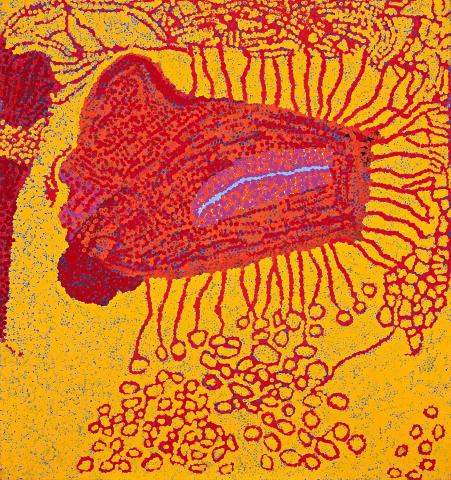UTJURI PUKARA, 2010
TOMMY WATSON
synthetic polymer paint on Belgian linen
153.0 x 144.0 cm
bears inscription verso: title and date
Agathon Gallery, Melbourne
Private collection, Melbourne
McGregor, K., (ed.), Yannima Pikarli Tommy Watson: Ngayuku Hgura My Country, MacMillan, Melbourne, 2010, p. 241 (illus.)
Tommy Watson's paintings are powerful statements of title to land.’ 1
Tommy Watson began painting in 2001, shortly after the formation of Irrunytju Community Art Centre of which he was a founding member. Watson paints both his grandfather's and mother's country, his knowledge of which has grown from a nomadic family life, which informs his paintings.
Demonstrating his creative ingenuity, Watson has created his own style using lines, dotting, and a powerfully vibrant use of colour to illustrate his paintings which skilfully merge both the stories of his Pitjantjatjara country and of the Dreaming. Watson created 'works of immense visual power and complexity distinguished by an outpouring of magical colours.’2 His application of minimal colour fields spreading across the canvas recall ancestral stories of his Pitjantjatjarra heritage, originating from one of the nation's most arid and unforgiving regions.
In Utjuri Pukara, 2010, Watson washes the surface of the canvas with blocks of colour overlaid with tracery lines of merged dots that Judith Ryan notes have an 'appeal' that relates to the spatial complexities and distinctively tactile topographical variations described through the use of luscious, thickly dotted layers of bright pink, whites, yellows, oranges, reds, purples, blues and greens. In expressing the intensity of his relationship to 'Country', Watson infers the potent and mysterious dimensions of his sacred world by sinking the visual elements into what becomes a 'prolonged meditation on art and life, space, time, perception and the nature of reality itself’.3
1. McGregor, K. and Geissler, M., Yannima Paikarli Tommy Watson, Macmillan Art Publishing, Melbourne, 2010, p. 9
2. Ryan, J., Colour Power: Aboriginal Art Post 1984, National Gallery of Victoria, Melbourne, 2005, p. 112
3. Ibid.
